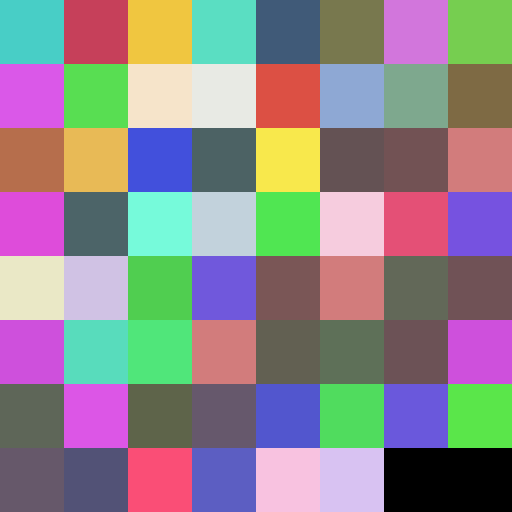

This png image hides something very special and beautiful. The first person to decode it will be rewarded with a Ṁ100 manalink, and another Ṁ100 will be given to the first person who explains it's meaning/significance/beauty, before this market closes.
This market resolves YES if someone claims BOTH of those rewards in the next 72 hours, 50% if the image is decoded but not explained, and NO if nobody decodes it.
This is not a trick question, and after the market closes I'll share an easy encoding-decoding method that I've used.
🏅 Top traders
| # | Name | Total profit |
|---|---|---|
| 1 | Ṁ204 | |
| 2 | Ṁ34 | |
| 3 | Ṁ18 | |
| 4 | Ṁ0 |
People are also trading
Dividing the rgb values by two and then converting them to ascii gives you the text:
$gcc -xc -oa -<<<'i;n;g(m,t,o){return("GTj?TG?5"[7&t]+!(n&12|t&2)*9)*i>>o&m&24;}main(s){for(;;)putchar(g(8,n=++i>>14,8)+g(n,n^(s=i>>10)/8,6)+g(n/3,n+s/2%3,6)+g(n/5,n-s%3,5));}';./a|aplay
Which (barring any extra layers of encipherment) is a code golf-esque c program that plays a nice song on your computer :) a la this video starring everybody's favorite alignment researcher https://www.youtube.com/watch?v=MqZgoNRERY8
I couldn't get aplay to work on wsl2, but piping the program output to a file and loading it in RAW format into audacity let me listen to it well enough :^)
@brubsby YES! You are absolutely correct, you get both rewards :)
Pls contact me on discord and I will send you the manalink.
I really-really like the sound of Bitshift Variations in C Minor by Robert Miles, and my brain simply can't fully comprehend how such a beautiful music piece can fit into an 8x8 png image.
This is the actual reason why I created this market: to share a thing that I admire.
Btw, the png can be easily decoded using those two lines of python code:from PIL import Image
print(bytes(np.array(Image.open("hrhm0SC0Ni.png"))[::64,::64].reshape(-1) // 2).decode("utf8"))
It was a good extra little bit of encipherment, and was the final step in me figuring it out, I was trying to map the values onto ascii or unicode somehow, and I had noticed every number was congruent to 0 mod 2, so simply tried dividing by 2, and it got it right in the range to map directly onto ascii, and when I tried it out, out popped the code!
Funnily enough, I used GPT-4 to generate some code that used PIL to convert it into RGB values so I could put it into AZdecrypt, super handy.
i like ciphers
fairly confident it's not just the r g b r g b r g b ... values used as codes for a simple substitution cipher, this sequence represents that:
72 206 198 198 64 90 240 198 64 90 222 194 64 90 120 120 120 78 210 118 220 118 206 80 218 88 232 88 222 82 246 228 202 232 234 228 220 80 68 142 168 212 126 168 142 126 106 68 182 110 76 232 186 86 66 80 220 76 98 100 248 232 76 100 82 84 114 82 84 210 124 124 222 76 218 76 100 104 118 250 218 194 210 220 80 230 82 246 204 222 228 80 118 118 82 224 234 232 198 208 194 228 80 206 80 112 88 220 122 86 86 210 124 124 98 104 88 112 82 86 206 80 220 88 220 188 80 230 122 210 124 124 98 96 82 94 112 88 108 82 86 206 80 220 94 102 88 220 86 230 94 100 74 102 88 108 82 86 206 80 220 94 106 88 220 90 230 74 102 88 106 82 82 118 250 78 118 92 94 194 248 194 224 216 194 242 0 0 0 0 0 0
58 unique "symbols" when split into rgb separately, which seems suspiciously low for 256 possible symbols, so it's possibly a promising direction. when split directly from their unique colors, there are 62 unique symbols, which seems to imply the colors as a whole are likely not to be considered as symbols.
the two black pixels at the end seems to imply there are only 62 meaningful pixels, and the last two are padding in some sense, which also seems to imply standard left-to-right, up-to-down read order.
the last two pixels also remind me of base 64 "==" padding that follows at the end of a base64 encoded text. but there doesn't seem to be a nice way to map this sequence directly into base64. especially if each color is to be taken independently, as this would imply 6 padding characters, not something supported in base64.
@brubsby hmm each rgb channel per character was my first guess, too. but that's giving me nonsense so far. "HÎÆÆ@ZðÆ@" for the first 9 characters. def something else going on. But the repetitions of certain numbers feel important. word-like at first, but then there's soon a triple... (120 120 120)
@Stralor that was the <<< in the program! A repeated trigram kind of threw me off too, but I thought I was looking at mostly english text until the program popped out.
